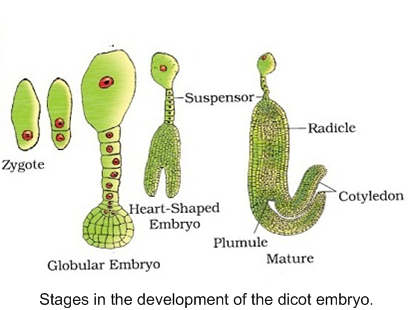(a) Explain the different ways apomictic seeds can develop. Give an example of each.
(b) Mention one advantage of apomictic seeds to farmers.
(c) Draw a labelled mature stage of a dicotyledonous embryo.a. Different ways by which we can develop apomictic seeds include-
1. Formation of diploid egg i.e embryo without undergoing reduction division or fertilization e.gAsteraceae
2. Some nuclear cell divides surrounding the embryo sac divide continuously surrounding before protrude into embryo sac ultimately develop into embryo e.g Mango
b. Advantage of apomitic seeds for farmers include reduce cost of seed purchase, They can keep the hybrid seeds once purchases for next season.
(c)

(a) hypocotyl and epicotyl
(b) Coleoptile and coleorhiza
(c) Integument and testa
(d) Perisperm and pericarp.
With a neat labelled diagram, describe the parts of a typical angiosperm ovule.
What is self-incompatibility? Why does self-pollination not lead to seed formation in self-incompatible species?
Name the parts of an angiosperm flower in which development of male and female gametophyte take place.
(a) Draw a diagrammatic sectional view of a mature anatropous ovule and label the following parts in it:
(i) that develops into seed coat.
(ii) that develops into an embryo after fertilization.
(iii) that develops into an endosperm in an albuminous seed.
(iv) through which the pollen tube grains entry into the embryo sac.
(v) that attaches the ovule to the placenta.
(b) Describe the characteristic features of wind pollinated flowers.(a) Explain the post-pollination events leading to seed production in angiosperms.
(b) List the different types of pollination depending upon the source of pollen grains.